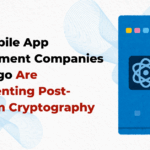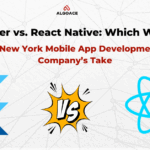
Mobile applications have increasingly become a fundamental aspect of our everyday activities, and their design and development are advancing at a swift pace. As the demand for enhanced user experiences rises, companies are allocating greater resources toward UI/UX design and development services to produce apps that are intuitive, functional, and aesthetically pleasing. This article will examine the most recent advancements in UI/UX design and development services for mobile applications, encompassing cutting-edge technologies and emerging design trends. Furthermore, we will investigate how software development services are integrating these innovations to enhance the overall mobile app experience.
The Role of UI/UX Design and Development Services in Mobile App Success
It is essential to grasp the fundamental role of UI/UX design and development services in mobile applications before exploring the latest advancements. The user interface (UI) and user experience (UX) represent the initial points of interaction for users upon launching an app. An effective UI/UX design guarantees that an application is user-friendly, aesthetically pleasing, and delivers a satisfying experience. Conversely, software development services are responsible for the backend operations and functionalities that ensure the app operates smoothly.
UI/UX design and software development services collectively constitute the foundation of a successful mobile application. However, as technology progresses, so too does the methodology for mobile app design and development.
1. The Integration of Artificial Intelligence (AI) and Machine Learning (ML)
AI-Powered Personalization
One of the most notable advancements in UI/UX design and development services is the incorporation of Artificial Intelligence (AI) and Machine Learning (ML) algorithms to deliver tailored user experiences. These technologies enable applications to assess user behavior and modify the interface and content according to personal preferences.
For example, e-commerce applications leverage AI to recommend products to users based on their previous browsing activities and purchases. Additionally, AI can enhance app navigation by anticipating which features users are inclined to engage with next, thereby rendering the interface more intuitive and efficient.
Smart User Interfaces
Artificial intelligence is significantly improving the visual and interactive features of mobile applications. Intelligent user interfaces, driven by machine learning algorithms, have the capability to adapt the interface to meet various user requirements. For instance, an application might modify its color palette or arrangement based on factors such as the time of day, weather conditions, or user behavior. Such adaptive modifications contribute to a more immersive and captivating user experience.
2. Voice User Interface (VUI) and Conversational Design
The Rise of Voice Assistants
Voice User Interfaces (VUI) are increasingly becoming prominent in the realm of mobile application development. The popularity of voice assistants such as Siri, Alexa, and Google Assistant has led users to anticipate voice interaction capabilities within applications. VUI facilitates hands-free navigation, thereby simplifying the process for users to accomplish tasks without the need for screen interaction.
In the context of UI/UX design and development services and WordPress development services, the incorporation of voice commands into applications empowers users to execute actions such as sending messages, retrieving information, or setting reminders through straightforward voice instructions. As advancements in voice technology progress, its incorporation into mobile applications is expected to expand significantly.
Conversational Design
Conversational design, encompassing chatbots and virtual assistants, represents an emerging trend in the realm of mobile application UI/UX design and development services. These chatbots are engineered to mimic human dialogue, thereby offering users a more tailored experience. They are capable of responding to inquiries, suggesting products, and even troubleshooting problems autonomously.
For instance, numerous e-commerce applications have integrated chatbots to aid users in locating products, monitoring order statuses, or handling customer service questions. By embracing conversational design, developers can enhance user engagement and streamline the overall experience.
3. Augmented Reality (AR) and Virtual Reality (VR)
Enhancing User Engagement with AR/VR
Augmented Reality (AR) and Virtual Reality (VR) are revolutionizing the design and development of user interfaces and user experiences for mobile applications. These innovative technologies provide immersive environments that enable users to engage with applications in unprecedented manners. By superimposing digital elements onto the physical world (AR) or constructing entirely virtual settings (VR), mobile applications can deliver highly interactive and captivating experiences.
One of the key industries reaping the benefits of AR/VR technologies is retail. For example, applications focused on furniture and home decor now empower users to visualize how specific items would appear in their living spaces through AR. Likewise, in the beauty sector, AR applications allow users to virtually apply makeup before making a purchase decision.
The incorporation of AR/VR into mobile app UI/UX design and development necessitates specialized knowledge and cutting-edge technologies. Nevertheless, it presents a substantial opportunity to boost user engagement and craft unforgettable experiences.
4. Biometric Authentication for Enhanced Security
Fingerprint and Facial Recognition
As security concerns continue to rise among mobile application users, UI/UX design and development services are increasingly integrating biometric authentication methods, including fingerprint scanning and facial recognition. These functionalities enable users to access their applications securely and effortlessly, eliminating the need to recall passwords or PINs.
The significance of biometric authentication is especially pronounced for applications that manage sensitive information, such as those related to banking, healthcare, or financial transactions. By providing a more secure means of logging in, developers can enhance user confidence and mitigate the likelihood of unauthorized access.
User Experience Considerations
Biometric authentication provides improved security; however, it is essential for UI/UX design and development services to integrate these features in a manner that preserves the user experience. The implementation must be swift, intuitive, and seamless, allowing users to access the application without encountering frustration or delays.
5. Dark Mode and Light Mode
The Popularity of Dark Mode
Dark mode has emerged as a highly sought-after feature in mobile applications in recent years. A significant number of users favor the darker interface as it alleviates eye strain, particularly in dimly lit settings. In light of this growing preference, UI/UX design and development services and custom app development services are increasingly providing applications that support both dark and light modes, enabling users to select their desired theme according to their individual tastes.
From a design standpoint, implementing dark mode necessitates careful consideration of contrast and readability. It is essential that text remains clear against darker backgrounds, and that elements such as buttons and icons are easily identifiable. By allowing users the option to switch between dark and light modes, a more tailored experience is achieved.
6. Minimalist and Micro-Interaction Design
The Shift Toward Minimalism
Minimalism remains a significant trend in the realm of UI/UX design and development for mobile applications. As users increasingly seek quicker and more intuitive interactions, designers are prioritizing simplicity. A minimalist approach minimizes clutter and emphasizes the app’s essential features, facilitating easier navigation for users.
By removing superfluous elements and refining navigation, mobile applications can deliver a more polished and efficient user experience. This strategy not only boosts usability but also elevates the app’s aesthetic appeal.
Micro-Interactions for Enhanced Engagement
Micro-interactions refer to the minor, nuanced animations or responses that take place when users engage with an application. Instances of these include effects when hovering over buttons, notifications, or indicators of progress. Although frequently disregarded, these interactions are essential for improving the overall user experience.
Incorporating micro-interactions into UI/UX design and development services allows developers to offer users immediate feedback regarding their actions, thereby enhancing the app’s interactivity and responsiveness. Such subtle animations contribute to a more captivating and pleasurable user experience.
7. Progressive Web Apps (PWAs)
The Rise of PWAs in Mobile App Development
Progressive Web Apps (PWAs) are transforming the landscape of mobile application UI/UX design and development by integrating the most advantageous elements of both websites and mobile applications. These applications are crafted to deliver an experience akin to that of native apps while remaining accessible via a web browser, thereby removing the necessity for users to download applications from an app store.
The advantages of PWAs are numerous, including rapid loading speeds, offline capabilities, and straightforward installation processes. Furthermore, they enable developers to build a single application that functions seamlessly across various platforms, thereby minimizing both development time and costs. With an emphasis on performance and user engagement, PWAs are increasingly being recognized as a preferred option for mobile application development.
Conclusion
The mobile application sector is experiencing rapid innovation, with UI/UX design and development services leading this evolution. Current trends emphasize the use of AI-driven personalization, the incorporation of augmented and virtual reality, voice interfaces, and biometric security measures, all aimed at enhancing user engagement, efficiency, and safety.
For organizations striving to maintain a competitive edge, it is essential to collaborate with a software development services provider that is attuned to these emerging trends. By adopting the latest advancements in mobile application design and development, businesses can create applications that align with the changing preferences of users, improve user satisfaction, and foster sustainable success.
Through the application of these cutting-edge strategies, UI/UX design and development services will continue to influence the future of mobile application experiences, rendering them increasingly intuitive, personalized, and immersive.





 Welcome to Algoace!
Welcome to Algoace!
0 Comments